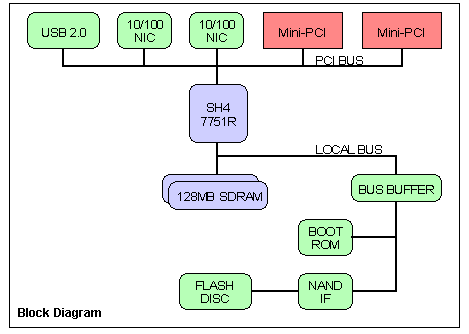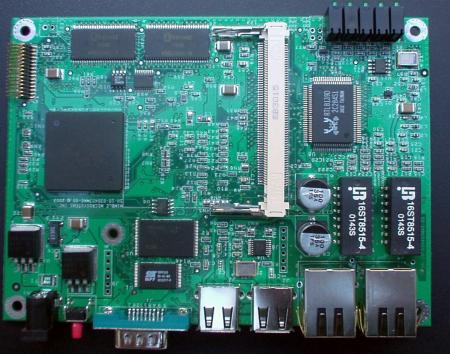Small, low-cost Linux system targets wireless networking apps
Jul 6, 2004 — by LinuxDevices Staff — from the LinuxDevices Archive — 1 views [Updated Dec. 9, 2004] — Nimble Microsystems is shipping a small, low-power, SuperH-based fanless computer that comes with Linux, supports PoE (power-over-Ethernet), and has two Ethernet ports and two mini-PCI slots suitable for 802.11x wireless cards or other internal expansion. Available in single quantities for $250, the TNP-51R targets networking applications such as routers, firewalls, VPN, spam and content filters, RFID savant, webcams, and video servers.
[Updated Dec. 9, 2004] — Nimble Microsystems is shipping a small, low-power, SuperH-based fanless computer that comes with Linux, supports PoE (power-over-Ethernet), and has two Ethernet ports and two mini-PCI slots suitable for 802.11x wireless cards or other internal expansion. Available in single quantities for $250, the TNP-51R targets networking applications such as routers, firewalls, VPN, spam and content filters, RFID savant, webcams, and video servers.
(Click for larger view of the TNP-51R)
The TNP-51R is based on a 240MHz SH4-7751R processor, a highly integrated system-on-chip (SoC) with a 2-way superscalar 32-bit RISC architecture, IEEE754 floating point engine with DSP acceleration, MMU (memory management unit), 16-bit fixed instruction length for low memory footprint, and an integrated PCI controller. The SH4-7751R is one of the processors supported by CELF Linux, a distribution optimized for consumer electronic devices.

TNP-51R architecture
The little system measures 5.7 x 4.12 x 0.87 inches (145 x 105 x 22mm) and comes with 64MB or 128MB of NAND Flash Memory, and 128MB of SDRAM clocked at 120MHz.
Nimble will additionally market a $50 multimedia mini-PCI card that adds AC97 audio and 1280 x 1024 x 18-bit color and 128-bit 2D graphics acceleration.

The TNP-51R's embedded SBC, based on an SH-4 SoC
The back of the board offers a second mini-PCI connector

An early prototype of the TNP-51R's SBC with a soldered-on RFID sensor
Network interfaces includes dual 10/100 Ethernet ports that support Nway autonegotiation, an IEEE standard method that active network components such as hubs and switches can use to establish connection parameters such as speed and full- or half-duplex status with Ethernet cards. Two mini-PCI sockets provide an expansion option for 802.11x Wireless LAN cards.
One Ethernet port supports 802.3af PoE (power over Ethernet), a feature that can simplify wiring when the device is placed in hard-to-access locations such as antenna towers or rooftops. Nimble says that the entire system draws a maximum of 2.6A and requires a 5VDC voltage input.
Additional I/O interfaces include two USB 1.1 host controllers based on OHCI. OHCI, or Apple-style USB, generally works better with video streaming applications than Intel-style UHCI controllers under Linux. The board also includes one USB 2.0 EHCI controller compliant with USB Specification Rev. 2.0 (supports 1.5/12/480 Mbps).
The TNP-51R also includes a smart card interface with SIM Socket for security processing applications.
Software side
On the software side, the TNP-51R ships with a “complete and ready to run” linux 2.6 kernel that supports hotplug scripts, iptables, hostap, wlan-ng, and other standard linux software.
Two filesystems are provided, including a minimal runtime environment, and a more complete development environment with a native GNU toolchain. Both use the standard GNU/linux Glibc, to facilitate application porting.
The distribution is based mostly on RPMs from sh-linux.org, Nimble says. It also includes Nimble's NAND flash block device driver, which supports an EXT3 journaling file system.
The TNP-51R is available now, and the multimedia mini-PCI add-on is nearing completion, Nimble says.
This article was originally published on LinuxDevices.com and has been donated to the open source community by QuinStreet Inc. Please visit LinuxToday.com for up-to-date news and articles about Linux and open source.